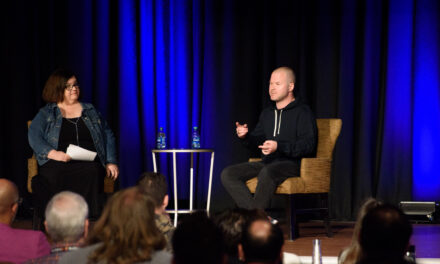The smell of burnt rubber and champagne fills the air. A flash of fireworks invades my eyes and my ears are still ringing from the roar of engines now silenced. With confetti raining down around us, a hundred lenses all turn in unison to capture one man standing on a car. I lean over to one of the cameramen firing away with his massive lense — which probably cost more than my car. “I bet you I’ll beat you online!” I say with a smile. He smiles back as he eyes my iPhone. “You might be faster, but my quality will blow yours away,” he responded. Turns out we were both right in this story of digital media.
This light-hearted exchange took place on August 21, 2009, at 10:24 pm EST in victory lane at Bristol Motor Speedway. Over the last seven years as an MC for one of the most popular tracks in NASCAR, I have had a chance to hang out and work with some very talented photographers and videographers. My professional photographer friend would have to snap photos for the next 30 minutes and then walk down to the media center to upload the photos to his laptop and then online. The photo I snapped with my iPhone 3G was taken at 10:24 pm EST, uploaded to Flickr at 10:26 pm EST, and instantly shared on Twitter and Facebook. You can check out the photo here and see all the EXIF and location data to verify the story.
So which of us deserved a victory lap? Is the amateur shot better because it was uploaded first? Or is the professional shot the winner because of the better quality? How can content creators decide the right delivery methods for their target audience? In this edition of Content Throwdown, we will choose a champion in the ongoing “Amateur vs. Professional Battle Royale.”
Let’s be very clear, the line between amateur and professional is very blurry. You have seasoned directors shooting full-length movies on iPhones and neighborhood kids sporting HD Cameras and DSLRs. In 2009 the rows of photographers and cameramen in victory lane all armed themselves with top-of-the-line gear. In 2012 the high-end gear is still there but after snapping a few pro shots, they all switch over to their mobile device of choice to capture a few “amateur” images.
So what are some of the strengths in the “pro” column for the amateur media? “Speed” and “sharing” are the keywords to remember. If you have content that is time-sensitive, use some consumer tools to get the word out. Tweeting an Instagram photo of a breaking news item or sharing a Viddy video on Facebook with a quick tip are great ways to leverage amateur tools to tell your story. The most powerful weapon in the non-professional arsenal is the ability to share. It may have only taken you 30 seconds to record a hot industry tip on your phone but the ripples through social networks can be felt for days and weeks. It’s important to note that the positives on the amateur side still require planning and education on your part. Setting up accounts and devices, finding followers, and coming up with a strategy can help you capture the moment and share it with an audience in real-time.
The professional side of this throwdown is easier to identify. If you want quality, go with the pro. Using professional talent and equipment will almost always produce better results. (Would you let some guy with an iPhone photograph your wedding?) Yes, it takes longer and costs more to produce professional results, but if you are creating a new ad campaign or filming the CEO’s yearly address, you want it to look fantastic. Having quality content also means that you can repurpose it across multiple outlets. The other upside for using veteran talent is that, in a pinch, they can produce awesome results with less than professional equipment.
So who wins in the ongoing content contest? The first winner is amateur equipment in the hands of a professional. The right individual can make incredible photos and videos on any device. This just goes to show that in hiring you want to find someone who has talent and experience first, then worry about what equipment they have. The runner-up in our throwdown is amateur equipment in the hands of amateurs. When someone with a mobile phone can scoop the major news networks and their satellite trucks, the power is firmly in anyone’s hand (literally). Cheap devices, cameras everywhere, and the 24/7 nature of global social networks definitely favor the amateurs.
Recently a veteran cameraman summed it all up for me: “There will always be a place in the market for professional production and the tools are definitely changing. But ultimately, it comes down to the person behind the viewfinder.” So next time you set out to create content the best question to ask is not what device are you going to use, but who is going to use it.






